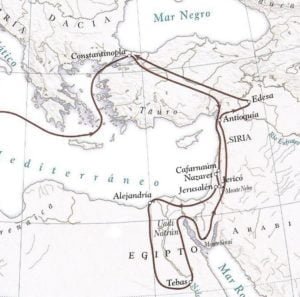Yes, you can say with me slowly…Hep-DOM-eh-dare-ree, a hybrid Greek-Latin term meaning People Who Kept a Week. Today we begin to keep the week of all Christian weeks, the holiest, most sacral chronology of the entire Christian year. Today we transform into pilgrims on an intensive peregrination of faith, which I called in an earlier reflection a primer of salvation. Our guide is Egeria, the 4th century Iberian (Spanish) nun whose pilgrimage journal outlines the ridiculously grueling, physically and emotionally demanding schedule of Holy Week worship enthusiastically kept by the emerging Byzantine Jerusalem church in those heady decades of newly-legalized Christianity. Learn about Egeria from our Reflection exactly one month ago here.(There are scads of great websites about her if you’d like to Google research her more extensively but don’t wait for the movie. Her Travels journal is a bit liturgically dense in places!). Egeria’s Holy Land was buzzing with pietistic energy as native Jerusalemite Christians endured massive Byzantine church building projects amidst waves of fervent peregrinati (pilgrims, the same Latin root used above) flooding into Jerusalem crowding the sacred places where Jesus taught, worshipped, ate, prayed, died and was resurrected….just like today.

Upon arrival Egeria learns the Jerusalem church calls this week the Great Week. She joins them on Saturday before the Great Week, or yesterday in our time, in Bethany at a church called the Lazarium, built over the tomb of Lazarus. There they celebrate Jesus’ resuscitation of Lazarus to prepare them for the week to come. Then the next day, the Day of Palms, after normal Sunday morning worship and a brief meal, the assembly meets atop Mount Olivet to pray and sing together throughout the afternoon. After the reading of the Palm Sunday gospel (which we read ourselves today during our home-based worship available here), Bishop Cyril led the assembly festively down the winding slope side of Olivet facing Jerusalem. Egeria’s journal captures the moment vividly:
All the people go before the Bishop with psalms and hymns, all the time repeating “Blessed is he that comes in the name of the Lord!!” All the children, including those who are not yet able to walk because they are too young and therefore are carried on their parents’ shoulders, all of them bear branches, some carrying palms, others olive branches. And the bishop is led in the same manner as the Lord once was led [i.e. on a donkey]… From the top of the mountain as far as the city and from there through the entire city … everyone accompanies the bishop the whole way on foot, and this includes distinguished ladies and men of consequence.
 Wow. The Bishop and Assembly complete their march in the rotunda of Constantine’s masterwork, the Church of the Holy Sepulcher, surrounding the place where Jesus was buried which was and is today inside the church. There they concluded the day with a beautiful lamp lighting evening worship, complete with singing and praying psalms, similar to our Compline. Many present would then not eat again until Easter evening seven days later, hence the original name of those fasting a week, i.e. a hebdomadarian.
Wow. The Bishop and Assembly complete their march in the rotunda of Constantine’s masterwork, the Church of the Holy Sepulcher, surrounding the place where Jesus was buried which was and is today inside the church. There they concluded the day with a beautiful lamp lighting evening worship, complete with singing and praying psalms, similar to our Compline. Many present would then not eat again until Easter evening seven days later, hence the original name of those fasting a week, i.e. a hebdomadarian.
Wow. The total distance covered, including steep ascents and declines, is over 5 miles and possibly more from Jerusalem’s upper district. The total time in worship today, almost 13 hours with a brief lunch. All to follow Jesus as he enters Jerusalem on a donkey while the Roman Procurator Pontius Pilate is literally marching into town from the other side, in ceremonial chariot, complete with full military escort. That’s what our forebears did with deep joy to simply apprentice with Jesus. What are we prepared to do?
- The peasant class of Jerusalem proclaimed Jesus as the triumphant Messiah coming to Jerusalem to claim his own on God’s behalf. How, precisely, is Jesus both Lord and Savior in our lives now? Have we ever verbally accepted Jesus’ sovereignty in our lives, and if not, could we today?
- Today is a great day to remember the moment we felt the greatest joy, experientially, being a Christian! When did we march, dance and sing for joy to welcome Jesus into our life?
- The entrance to Lazarus’ Tomb is here, the Lazarium today here and here. Mount Olivet, here. A modern Jerusalem Palm procession is here. Constantine’s Sepulcher, lost to history, is sketched here, the Byzantine and Crusader reconstruction exterior here. We’ll go inside later this week, but for now, the dome is situated exactly where Constantine’s was also, directly over the tomb of Jesus. For a taste of Egeria in more depth read this and that. (Apologies for the annoying pop-ups on the “that!”)
Please read also the April 6 reflection, Claim the Day.